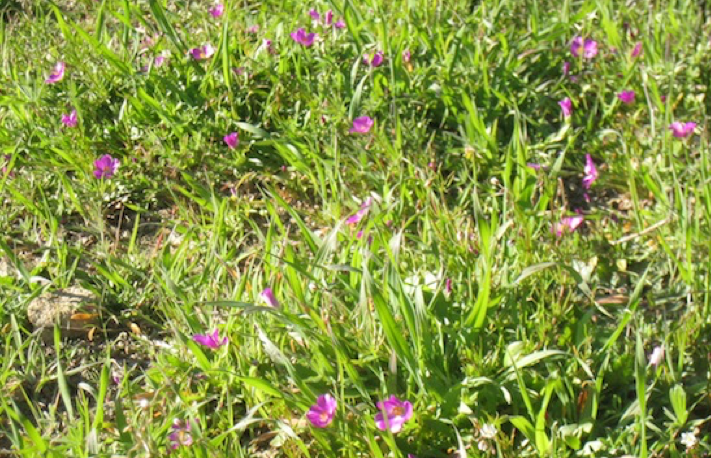AMAH MUTSUN ETHNOBOTANY
By Sara French, AMLT Research Associate

Photo courtesy Joe Decruyenaere, CC BY 2.0
Ethnobotany is the study of the human relationship with plants. Each AMLT newsletter highlights a native plant that is used by the Amah Mutsun. We hope you enjoy learning more about the useful and culturally significant plants all around us.
Mutsun name: saapah
California Spanish name: pil
Common name: red maids
Scientific name: Calandrinia ciliata
Red maids are an inconspicuous but important plant food for the Amah Mutsun. They grow in grasslands throughout Amah Mutsun territory, and respond especially well to disturbances such as fire, mowing, scraping, or grazing. Red maids grow close to the ground and look similar to grass from a distance, but if you get close you will notice each plant has a basal rosette, with linear to spoon-shaped leaves along spreading, sometimes reddish stems, and small magenta flowers with five petals that open when the sun is shining. Red maids begin blooming as early as February and they tend to complete their annual life cycle by May. Both the young leaves and the seeds of the red maids are edible.
The Amah Mutsun have stories about their ancestors gathering red maids seeds in great quantities. Red maids were abundant enough under indigenous management, especially regular burning, that the people would make fist-size balls out of the tiny (1-2 millimeter), oily seeds, with one ball feeding one person. Imagine how many seeds would be gathered to feed hundreds of Mutsun people! Today in unmanaged grasslands, you would be hard-pressed to gather enough seeds to make one meal, let alone feed a family. But in areas that have been burned, mowed, or grazed, the Amah Mutsun still observe dense patches of red maids that seem to appear out of nowhere when conditions are right. For example, after the Amah Mutsun and the National Park Service conducted a prescribed fire to restore basket weaving grasses at Pinnacles National Park in 2011, red maids were seen carpeting the sandy soil in between the burned bunch grasses, while in prior years they were only observed in a few small patches. Maybe you will see some this spring, and take a moment to honor the tiny saapah that provided food to generations of California Indian people.
Please do not reproduce this material without permission.







